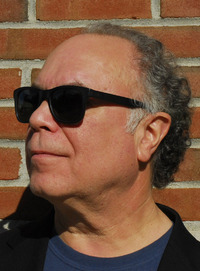FUMES
 Monday, August 9, 2010 at 02:35PM
Monday, August 9, 2010 at 02:35PM August 11, 2010
One of the greatest gets his due.
By Peter M. De Lorenzo
Detroit. Over the years of doing this publication I've made no secret of the fact that I believe Dan Gurney to be one of the giants of American racing. As a matter of fact, if there was ever a Mount Rushmore-like edifice created that was devoted to the subject, Gurney would be there, along with just a very few others. My list would include Gurney, Jim Hall (responsible - along with a cadre of devoted GM enthusiast engineers - for some of the most influential innovations in racing history), Roger Penske (as legendary team owner and as a driver), Carroll Shelby (I'm not and will never be a fan of the ruthless, mercenary/huckster side of him, but there's no denying the historical impact of the Shelby-American years on American racing), Mario Andretti (simply one of the greatest all-around drivers who ever lived), A.J. Foyt Jr. (the "who was better?" debate about A.J. and Mario will go on indefinitely) and Phil Hill, America's first World Champion.
But digging deeper, Dan stands alone because his brilliance behind the wheel was matched by the innovative brilliance that he brought to the technical side of the sport for over 40 years. And the impact of his willingness to push the envelope and move the sport forward into the future - something anathema in this narrowly-focused, spec racing world we live in today - cannot be overestimated. Dan's influence still resonates throughout the sport today - even though it falls on deaf ears for the most part - and therein lies the rub.
The innovative mind of Dan Gurney - still alive and bristling with visionary thoughts and perspectives at age 79 - should be guiding the sport, especially the sport of IndyCar racing. I suggest you read my colleague Gordon Kirby's excellent piece on Gurney here, complete with Dan's up-to-the-minute perspectives on where the sport has been, where it is today, and most important, where it needs to go in the future. After reading it you will begin to understand why Dan is as vital and on-point as he's ever been, especially about what this sport is woefully lacking today.
If you want to know why I am constantly railing against what the sport has become - a contrivance mired in spec racing hell led by groups hell bent on promoting mediocrity at every turn - read what Dan Gurney has to say about the subject, because I am in total agreement with him and I'm mad as hell that people aren't listening to him.
As a matter of fact, over three and one-half years ago when I gathered some of the racing's leading representatives to a meeting in Detroit to discuss the future of the sport and enlist momentum and support to launch the sport in a new direction - with an innovative form of racing based on racing electric vehicles powered by hydrogen fuel cells designed to invigorate the Indy 500 and the Indianapolis Motor Speedway - I said the following:
"We have formed the Hydrogen Electric Racing Federation for one very important reason – and it goes far beyond the fact that the management of the world’s resources has become a global concern and priority – a priority that we of course share. The real heart of the matter is that I believe racing needs a new idea.
As much as I love the sport and as much as many people in this room love the sport, it’s clear that we can’t continue on the path we’ve been going. Racing has devolved into a constant battle of wrestling with technology in order to rein it in, so that it can be made to conform to a particular rules 'package' in order to keep speeds down to a target number. Because of this, much of the 'reason for being' for racing, which always centered on the idea of 'improving the breed,' has been lost in this shuffle of constant corrective regulations, which inherently stunt creativity and dramatically limit innovation – essentially stifling the two essential elements that racing has always thrived on.
And so, racing too often regresses into a form of 'racertainment' – an orchestrated dance that exists in a vacuum unto itself, one that isn’t focused on advancing the development of future technologies for our production automobiles as much as it exists for pure entertainment value.
Not that there’s anything wrong with the scintillating entertainment that a crackling good motor race can provide, I might add. But I think that as automobile manufacturers, it is time for you to reassess the reasons for your involvement in motorsport.
Are you there to win? Of course. At least I would hope so. If you aren’t, then something is critically wrong with the way you’re going about it. But are you actually learning anything while you’re doing it? Or are you merely advancing the status quo to meet the vagaries of the next rules package? To me, this is the ultimate question before us today.
And that is why I believe it is time to press the 'reset' button for racing, not only to usher in a new era of creativity and innovation to the sport, but also to enable racing to take its rightful place again as the principal conduit for the transference of advanced technologies and innovations directly to our future production vehicles.
In short, it is time for the Future of Racing."
That meeting heralded a new beginning for the sport, but due to the declining financial fortunes of the domestic and import automakers in attendance, the concept never got off of the ground. But much of the thinking brought forth that day lives on today in various forms and continues to influence the thinkers involved in making racing better. And an interesting footnote? One man stepped forward to let me know that he was eager to participate in pressing the reset button for racing, and that he would be willing to design and build the cars that would take the sport in a new direction.
And yes, that man was Dan Gurney.
This coming weekend, the Rolex Monterey Motorsports Reunion (at Mazda Raceway Laguna Seca) will honor "Dan Gurney - the Cars He Built, the Cars He Drove" including a special reception at the track Saturday evening and a complete display of his most famous racing cars. I hope those in attendance will appreciate the depth and breadth of Dan Gurney's on-track achievements as well as his technical contributions to this sport, because his legacy is awe-inspiring.
It's just too bad that the current powers that be have relegated Dan's position in the sport to that of an "honorary" one, because he is the one man who could lead this sport out of the wilderness and toward a vibrant and relevant future.
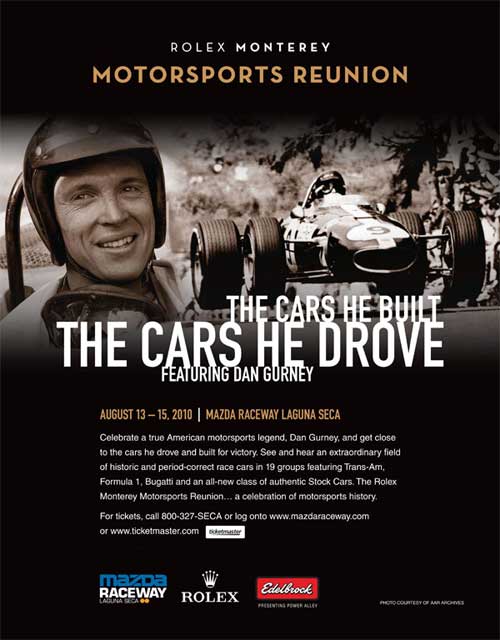
Publisher's Note: As part of our continuing series celebrating the "Glory Days" of racing, we're proud to present another noteworthy image from the Ford Racing Archives. - PMD
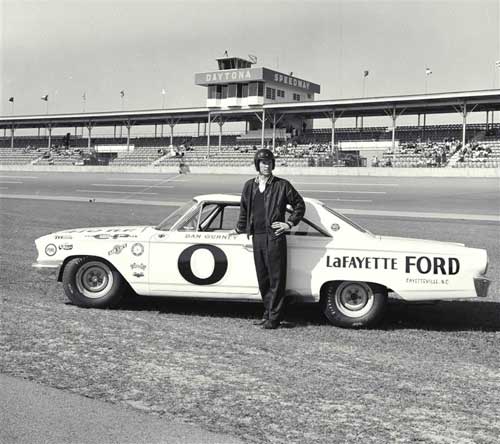 (All photos courtesy of the Ford Racing Archives)
(All photos courtesy of the Ford Racing Archives)
Dan Gurney standing by his 1963 Ford at the Daytona Speedway before that year's Daytona 500. Gurney qualified 11th and finished 5th behind winner Tiny Lund, Fred Lorenzen, Ned Jarrett and Nelson Stacy. Gurney won five NASCAR Grand National Races ('63, '64, '65, '66 and '68), all at Riverside International Raceway in California. In 17 NASCAR Grand National starts he would record three poles and five wins.
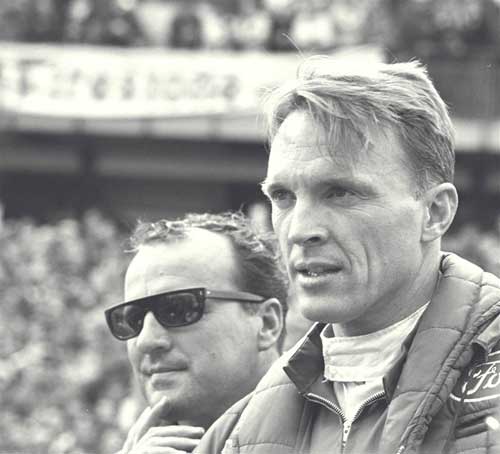 A.J. Foyt and Dan Gurney after winning the 24 Hours of Le Mans in 1967. The foreign media chided Gurney and Foyt as being out of their element in the endurance racing arena and predicted certain failure. Instead Gurney and Foyt paced themselves and then smoked the field for the win. To this day it remains the greatest single achievement in American racing history by an all-American team on foreign soil, in the most famous - and prestigious - endurance road racing event in the world.
A.J. Foyt and Dan Gurney after winning the 24 Hours of Le Mans in 1967. The foreign media chided Gurney and Foyt as being out of their element in the endurance racing arena and predicted certain failure. Instead Gurney and Foyt paced themselves and then smoked the field for the win. To this day it remains the greatest single achievement in American racing history by an all-American team on foreign soil, in the most famous - and prestigious - endurance road racing event in the world.
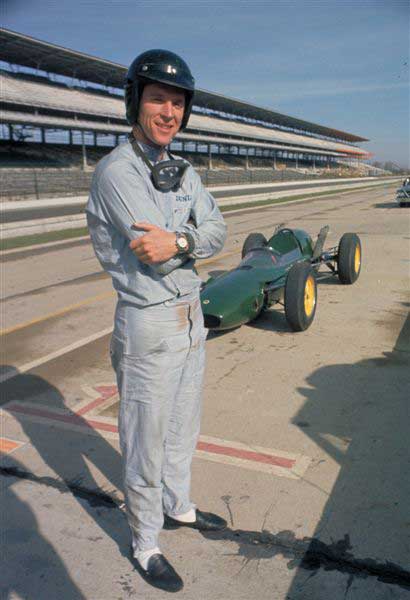 Ever the thinker and innovator, Gurney was responsible for bringing the Ford Motor Company and Colin Chapman - of Lotus fame - together to make an assault on the Indianapolis Motor Speedway and the Indianapolis 500. And it would change the face of American open-wheel racing forever. Here, Gurney stands in front of the tiny Lotus "Powered by Ford" at its first test at The Speedway in 1963. Dig the driving shoes!
Ever the thinker and innovator, Gurney was responsible for bringing the Ford Motor Company and Colin Chapman - of Lotus fame - together to make an assault on the Indianapolis Motor Speedway and the Indianapolis 500. And it would change the face of American open-wheel racing forever. Here, Gurney stands in front of the tiny Lotus "Powered by Ford" at its first test at The Speedway in 1963. Dig the driving shoes!
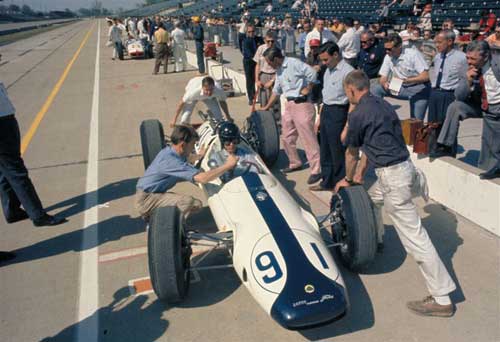 Several weeks later, now painted in its official livery (Jimmy Clark's team car was green with a yellow stripe in proper Lotus form, while Gurney's Lotus wore the internationally-recognized American racing colors of white with blue stripe) Dan Gurney prepares to take his Lotus "Powered by Ford" out for a practice session at The Speedway in 1963.
Several weeks later, now painted in its official livery (Jimmy Clark's team car was green with a yellow stripe in proper Lotus form, while Gurney's Lotus wore the internationally-recognized American racing colors of white with blue stripe) Dan Gurney prepares to take his Lotus "Powered by Ford" out for a practice session at The Speedway in 1963.
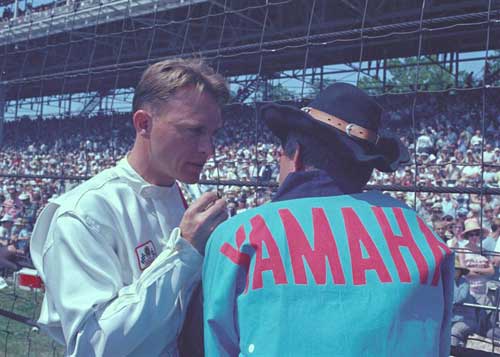 Dan Gurney talks to Carroll Shelby before the start of the 1965 Indianapolis 500. Gurney's Lotus-Ford entry was prepared by Shelby and sponsored by Yamaha.
Dan Gurney talks to Carroll Shelby before the start of the 1965 Indianapolis 500. Gurney's Lotus-Ford entry was prepared by Shelby and sponsored by Yamaha.
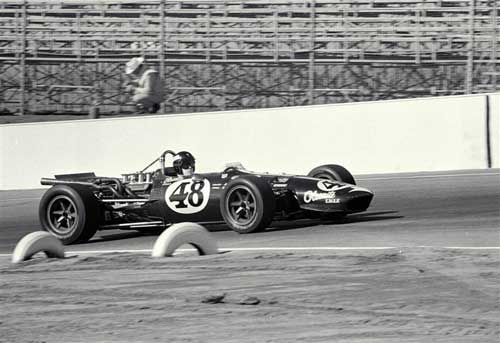 Dan Gurney drives his beautiful AAR Eagle Gurney Weslake-Ford to victory in the Rex Mays 300 Indy car race at Riverside in 1967. He would repeat the feat the following year. Watch a video of it here.
Dan Gurney drives his beautiful AAR Eagle Gurney Weslake-Ford to victory in the Rex Mays 300 Indy car race at Riverside in 1967. He would repeat the feat the following year. Watch a video of it here.
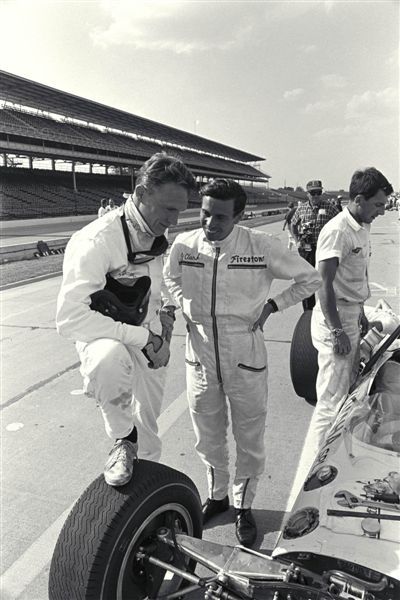 Dan Gurney and Jim Clark discuss things during practice for the 1965 Indianapolis 500. Jim Clark's father told Gurney after his son's death that Gurney was the competitor his son respected the most.
Dan Gurney and Jim Clark discuss things during practice for the 1965 Indianapolis 500. Jim Clark's father told Gurney after his son's death that Gurney was the competitor his son respected the most.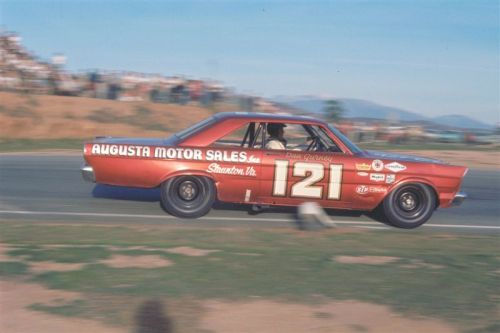 Gurney was damn near unbeatable in a Grand National stock car at Riverside. Here he is on the way to another win in the 1965 Riverside 500.
Gurney was damn near unbeatable in a Grand National stock car at Riverside. Here he is on the way to another win in the 1965 Riverside 500.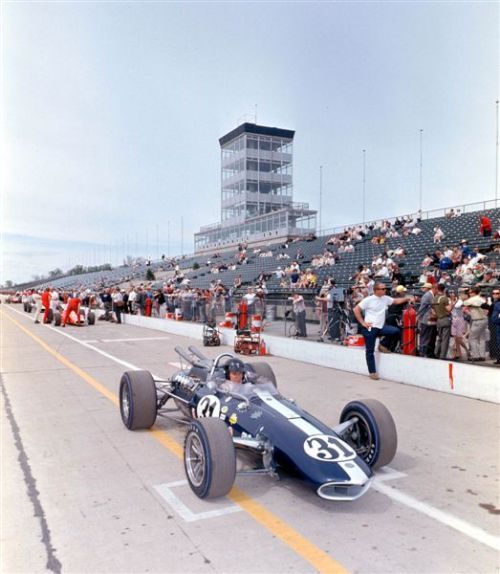 Dan Gurney leaves the pits at Indianapolis in 1966 in the first AAR Eagle Indy car built by his own company. Gurney's Eagles were some of the most beautiful race cars ever built.
Dan Gurney leaves the pits at Indianapolis in 1966 in the first AAR Eagle Indy car built by his own company. Gurney's Eagles were some of the most beautiful race cars ever built.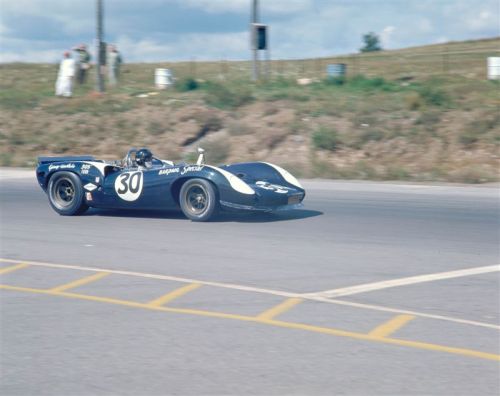 Bridgehampton, New York, 1966. Dan Gurney on his way to victory in the Can-Am series race in his Lola T70-Ford.
Bridgehampton, New York, 1966. Dan Gurney on his way to victory in the Can-Am series race in his Lola T70-Ford.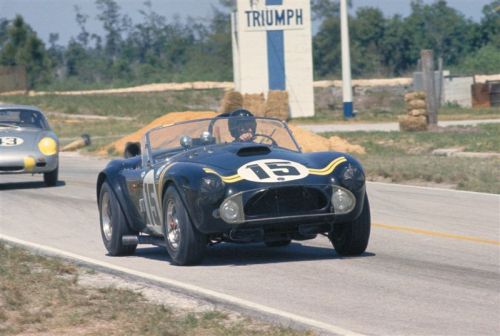 Sebring, Florida, 1963. Dan Gurney takes his factory Shelby American Cobra through the Webster turns. He and his co-driver, Phil Hill, encountered trouble and finished fourth in class.
Sebring, Florida, 1963. Dan Gurney takes his factory Shelby American Cobra through the Webster turns. He and his co-driver, Phil Hill, encountered trouble and finished fourth in class.
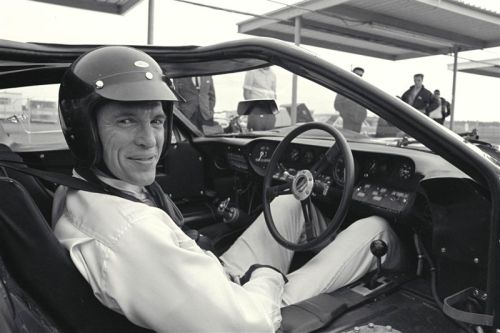 Daytona Beach, Florida, 1966. Dan Gurney in the cockpit of his Ford GT Mk II during practice for the Daytona 24 Hour race. Brilliant driver, risk-taking innovator and racing visionary, it's unlikely we'll ever see anyone like him again in this sport. - PMD
Daytona Beach, Florida, 1966. Dan Gurney in the cockpit of his Ford GT Mk II during practice for the Daytona 24 Hour race. Brilliant driver, risk-taking innovator and racing visionary, it's unlikely we'll ever see anyone like him again in this sport. - PMD
Publisher's Note: Like these Ford racing photos? Check out ford.artehouse.com. Be forewarned, however, because you won't be able to go there and not order something. - PMD
See another live episode of "Autoline After Hours" hosted by Autoline Detroit's John McElroy, with Peter De Lorenzo and friends this Thursday evening, at 7:00PM EDT at www.autolinedetroit.tv.
By the way, if you'd like to subscribe to the Autoline After Hours podcasts, click on the following links:
Subscribe via iTunes:
http://itunes.apple.com/WebObjects/MZStore.woa/wa/viewPodcast?id=311421319
Subscribe via RSS:
http://www.autolinedetroit.tv/podcasts/feeds/afterhours-audio.xml

